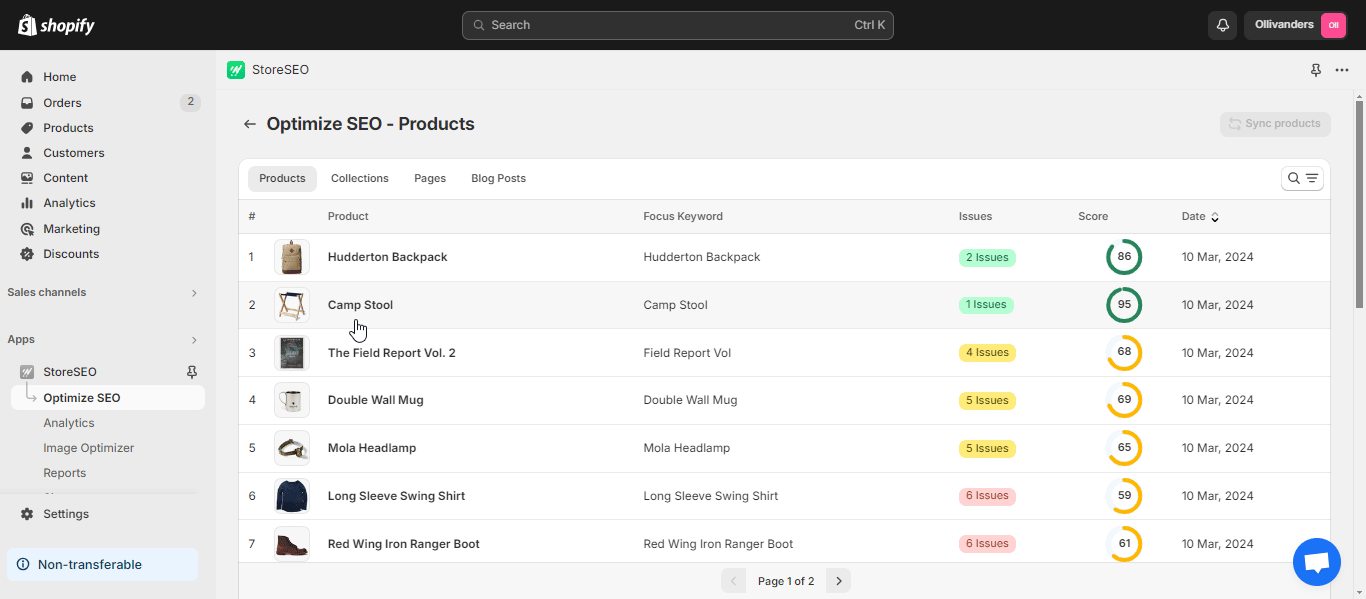在竞争激烈的 Shopify 商店中,SEO 友好 URL 的重要性不容忽视。这些网站的小组件具有巨大的力量,是内容与潜在客户之间的重要桥梁。但如何为 Shopify 创建和更改 SEO 友好 URL,以及什么才是 URL SEO友好? 这是为了创建一种无缝体验,引导用户直接进入您的 Shopify 商店。在这篇博文中,我们将探讨如何优化 Shopify 商店的 URL 以获得更好的性能。

Shopify URL 的结构
当您使用 Shopify 设置在线商店时,了解 URL 的结构可以帮助您更好地管理网站。默认情况下,Shopify URL 具有可预测的模式。例如,产品页面通常如下所示:

“yourstore.com/products/你的产品名称”
同样,产品集合显示为“yourstore.com/collections/your-collection-name”。这种结构非常简单,有助于从一开始就保持事物井然有序。
URL 结构一致性对于用户导航和 SEO 的重要性
保持一致的 URL 结构不仅对 SEO 至关重要,而且对于增强用户导航也至关重要。一致的 URL 为访问者创建了一个可预测的环境,使他们更容易了解如何浏览您的网站以及点击链接后会发生什么。
从 SEO 的角度来看,逻辑且一致的 URL 结构可让搜索引擎更有效地抓取您的网站并了解各个页面之间的关系。这有助于提高您网站的索引和搜索结果排名。因此,保持 URL 井然有序且合乎逻辑对您的用户和您的 SEO 工作来说都是双赢的!
在 Shopify 中创建 SEO 友好 URL
在 Shopify 中拥有 SEO 友好的 URL 是提高商店知名度和提高其搜索引擎排名的关键步骤。让我们通过分步指南、URL 命名的最佳实践以及避免常见陷阱的技巧来分解如何实现此目标。
在 Shopify 中更改和创建 SEO 友好 URL
在 Shopify 商店中设置新页面时,务必确保您的 URL 针对搜索引擎进行了优化。具体操作方法如下:
URL 命名约定的最佳实践
为了充分利用您的 URL,请遵循以下最佳做法:
- 使用关键字: 在 URL 中添加相关关键字,有助于改善网页的 SEO。例如,如果您销售复古灯具,您的 URL 可以是“www.yourshop.com/vintage-lamps”
- 使用连字符分隔单词: 使用连字符来分隔 URL 中的单词,而不是下划线或空格。这让搜索引擎更容易阅读和理解它们。
- 保持小写:URL 区分大小写,因此请始终使用小写字母以避免混淆。
如何避免创建 URL 时常见的错误
要为 Shopify 创建和更改 SEO 友好 URL,很容易犯错误,这可能会损害您的 SEO。以下是一些避免这些错误的提示:
- 避免使用过长的 URL:保持 URL 简洁。较长的 URL 很难被搜索引擎处理,并且可能无法完整显示在搜索结果中。
- 避免使用特殊字符:特殊字符和符号可能会破坏您的 URL,使用户和搜索引擎均难以访问它。
- 不要堆砌关键词:虽然关键词很重要,但过度使用关键词会使您的 URL 看起来像垃圾内容。请谨慎使用关键词。
SEO友好URL的高级技巧
为 Shopify 创建和更改 SEO 友好 URL 对于提高您网站的可见性和用户体验至关重要。以下是一些优化 URL 的高级技巧和策略,尤其是在您使用 Shopify 等平台时。
用于创建和更改 Shopify SEO 友好 URL 的应用程序和第三方工具
Shopify 的默认 URL 结构通常对 SEO 友好,但在某些情况下,您可能需要为 Shopify 创建和更改 SEO 友好的 URL,并使其进一步满足您的特定 SEO 目标。例如,如果您希望定位特定关键字或使 URL 与用户搜索意图更加匹配,则可以考虑自定义 URL,而不仅仅是基本的“/products/”或“/collections/”路径。
Shopify 提供各种应用程序,可帮助你优化 URL,从而获得更好的 SEO 性能。 商店SEO 可以简化整个流程,使整个工作流程更加简单, 元字段编辑 也可以。要自定义 Shopify 中的 URL,您可以使用 StoreSEO 应用。请确保您已 安装并激活 访问应用程序之前,请先阅读本指南。以下是使用本指南的分步指南:
步骤 1:访问 StoreSEO 应用程序
让我们了解如何访问和编辑这些预览,以使您的商店更具吸引力。转到 StoreSEO,然后单击“优化 SEO”

第 2 步:选择产品
现在选择您想要编辑搜索引擎列表的产品,然后单击产品本身,您将进入优化部分。

步骤 3:编辑详细信息
现在,您将看到用于编辑产品 URL 以及其他元字段的字段。逐一浏览并进行相应的编辑。

步骤 4:检查最终预览
完成 URL 更改后,向下滚动并检查所提供的所有预览信息的预览。

这就是您可以轻松编辑和查看 Shopify 商店在 StoreSEO 上的搜索引擎列表的实时预览。
平台迁移期间维护 SEO 友好 URL 的策略
迁移到新平台可能具有挑战性,尤其是在保留 SEO 成果方面。要在平台迁移期间保持 SEO 友好的 URL,实施以下措施至关重要: 301 重定向 从旧 URL 移至新 URL。这可告知搜索引擎您的内容的新位置,从而帮助保持搜索引擎排名。
另一个策略是尽可能保持一致的 URL 结构。如果您之前的平台使用了有助于 SEO 成功的特定 URL 模式,请尝试在新平台中复制该结构。这种一致性有助于减少迁移对 SEO 的影响并提供无缝的用户体验。
使用工具和方法检查商店绩效
好吧,当您成功优化了 URL 后,就该检查性能了。当谈到密切关注您的 URL 在 SEO 游戏中的表现时,有很多工具和方法可以为您提供优势。首先,Google Search Console 是您的首选。它就像为您的网站配备了健康监视器。它向您显示您的 URL 在搜索结果中的表现,跟踪点击次数、展示次数和平均排名等指标。另一个强大的工具是 Google Analytics,它可以更深入地了解用户在点击 URL 后如何与您的网站互动。
对于那些想要更详细了解的人来说,SEMrush 和 Ahrefs 等工具就像是 SEO 的高倍显微镜。它们不仅可以跟踪 URL 性能,还可以帮助您监视竞争对手并了解可以改进的地方。这些工具提供有关关键字排名、反向链接配置文件等的详细报告,让您全面了解您的 SEO 状况。
如何解读来自 Google Search Console 和其他分析工具的数据
解读 Google Search Console 和其他分析工具中的数据似乎很困难,但关键在于知道要寻找什么。在 Google Search Console 中,专注于“效果”标签。在这里,您将看到您的网站在 Google 搜索中出现的频率(展示次数)、获得的点击次数以及您的平均搜索排名。这些指标可以告诉您很多有关您在搜索结果中的可见性和吸引力的信息。
和 谷歌分析,您可以深入了解用户点击后的行为。查看跳出率、每次会话的页面数和平均会话时长等指标,以衡量用户参与度。这些数据不仅可以帮助您了解用户如何找到您的网站,还可以了解他们到达网站后会做什么。
从更广泛的角度来看,SEMrush 和 Ahrefs 可以深入了解您的 URL 与竞争对手相比的表现。它们可以向您展示哪些关键词正在为您的竞争对手带来流量,哪些反向链接正在促进他们的 SEO 工作。这种竞争分析对于完善您的 SEO 策略非常有价值。
Shopify URL 结构对 SEO 的限制
Shopify 的 URL 结构整洁,但它有 一些限制,尤其是关于 搜索引擎优化 (SEO)。主要问题之一是固定 URL 路径,如 /products/ 和 /collections/,这些路径是强制性的。这可能会有点限制,因为您无法自定义这些部分以包含更多 SEO 友好关键字或将 URL 与您的页面内容完全匹配。此外,Shopify 不允许删除这些路径元素,这可能并不总是符合最佳 SEO 实践,因为最佳 SEO 实践通常更喜欢更简单、更直接的 URL。
根据性能数据调整 URL 策略
了解何时以及如何调整 URL 策略对于保持 SEO 领先地位至关重要。如果您注意到点击次数下降或搜索结果排名下降,可能是时候做出一些改变了。首先重新评估您的关键词。它们是否仍然相关且具有竞争力?Google Search Console 和 SEMrush 等工具可以帮助您确定哪些关键词表现不佳。
另一个关键调整是改进 URL 本身。确保 URL 简洁、包含相关关键字并准确描述页面内容。有时,即使是很小的更改(例如调整 URL 段以更好地匹配搜索查询)也会对用户找到内容的难易程度产生很大影响。
最后,不要忘记技术方面。如果您进行更改,请确保您的 URL 正确重定向,尤其是在网站迁移或大修期间。正确的重定向可以保留您的 SEO 精华并让用户登陆正确的页面。希望您已经理解了如何为 Shopify 创建和更改 SEO 友好 URL 的概念。
那么,你觉得我们的博客有用吗?如果你觉得有用,请 订阅我们的博客 获得更多提示、教程以及行业相关主题的更新。









